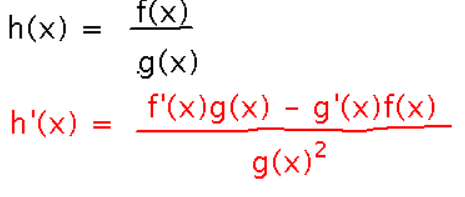AP Calculus AB Flashcards ❓❗
1/37
Earn XP
Description and Tags
𐙚‧₊˚📒✩ ₊˚☁️⊹♡
Name | Mastery | Learn | Test | Matching | Spaced |
|---|
No study sessions yet.
38 Terms
Pythagorean Identity #1
sin²θ + cos²θ = 1
Pythagorean Identity #2 (divide by sin²)
1 + cot²θ = csc²θ
Pythagorean Identity #3 (divide by cos²)
tan²θ + 1 = sec²θ
Double Angle Identity #1
sin2θ = 2sinθcosθ
Double Angle Identity #2
cos2θ = cos²θ - sin²θ = 2cos²θ - 1 = 1 - 2sin²θ
Double Angle Identity #3
tan2θ = 2tanθ/1 - tan²θ
lne = ?
1
ln 1 = ?
0
log 10 = ?
1
log 1 = ?
0
lognn = ?
1
logn1 = ?
0
logAB = ?
BlogA
log (A ⋅ B) = ?
logA + logB
(x,y) in terms of cos and sin
(cosθ, sinθ)
tan = ?
sinθ/cosθ
cotθ = ?
cosθ/sinθ
IVT
if a function is continuous on [a, b], and if k is any number between f(a) and f(b), then there must be a value in [a,b] such that f = k
end points aren’t equal, closed interval, continuous
definition of derivatives

point slope formula
y-y1 = m(x-x1)
d/dx
derivative
d/dx axn
a * nxn-1
d/dx sinx
cosx
d/dx secx
secx * tanx
d/dx a (a is a constant)
0
d/dx cosx
-sinx
d/dx cscx
-cscx * cotx
d/dx cotx
-csc²x
d/dx tanx
sec²x
d/dx lnx
1/x
logex
lnx
d/dx logax
1/lna * x
d/dx ex
ex
d/dx ax
lna * ax
product rule
d/dx f(x) * s(x) = (f(x))(s’(x)) + (f’(x))(s(x))
f(x) = sinx * cosx
f’(x) = cos2x
g(x) = cotx
g’(x) = -csc²x
quotient rule
